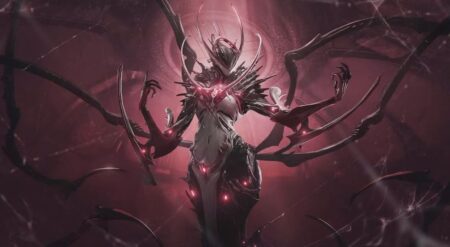With the launch of World of Warcraft‘s tenth expansion, The War Within, the entire community will be celebrating 20 years in Azeroth. Throughout its 20 years, WoW and its fanbase have had high highs and low lows. But everything feels different as we enter the third decade of Blizzard’s long-running MMORPG. BlizzCon 2023 gave us not one but three expansions, all enclosed in a new “saga,” the “Worldsoul Saga.” That and a new introduction of more long-term, game-changing features instead of one-off things that’d change after two years. We got to sit down with Maria Hamilton, Associate Design Director, and Mateusz Albrewcynski, Associate Lead Quest Designer, to talk about this new era for WoW, from its narrative to how the design philosophy of Blizzard has evolved in WoW’s 20 years of existence.
One major change from the past is a clear narrative between expansions. Before, expansions wouldn’t have their connection known until right around when that expansion launched. But now, we have three expansions that are building on the last to create a grand narrative. As the team is working on three expansions at once, each with different narrative beats to focus on, how does the team handle changes to the story that may have a waterfall effect to an earlier expansion? In other words, if someone wanted to create a very interesting story beat in, say, The Last Titan, how do they add that seed earlier in narratives that are more ready to ship?
In her answer, Hamilton gave a recent vague example of this. “As a specific example, I was in a meeting a week or two ago, where an amazing idea for The Last Titan came up. We realized for that to land, we needed to seed much earlier hints and clues that this might occur. And so this happens all the time, where we have something that we decide, ‘Oh, we really need to do this.’ This is a moment that our community is just going to love, but we recognize that you do have to be able to seed that in and hint toward that.”
So how does an MMO with a locked story for release adapt? Hamilton talked about how WoW has changed with Dragonflight to do just that. “In addition to our expansions themselves, with Dragonflight, we introduced the idea that in content updates, we would also continue the story, not just the large content updates, but also the smaller ones. So we have that opportunity to pace things out and adjust those. Add more touch points to help guide the story. So when we find opportunities like that, or when we realize we need to make a change, we do have that as an outlet to make sure that we’re doing a good job setting it up and that it’s not going to come out of nowhere.”

A great example of this incremental shift in Dragonflight’s narrative through patch content is Shaladrasil, a new world tree. Shaladrasil is now a home for all different versions of elves, alive, undead, fel corrupted, and those that followed Tindral to help burn the new world tree during its growth. But this all gives the sense that WoW is moving its roots away from the faction war. Instead of constant war with each other, players have felt like they are being moved on from as Azeroth’s denizens work more and more together. This has come across more in changes to established features, like cross-faction raiding, dungeons, and now cross-faction guilds. In addition to that, narratives of Dragonflight and future expansions like Midnight are building on this idea with cities that appear to be more race-focused instead of faction-focused.
In Midnight, we were pitched a new version of Silvermoon City, that will also serve as a new home for elves as we fight a void invasion. So does this mean that we are approaching an era where the entire game will be faction-agnostic? Will horde players be able to enter, say, Ironforge, or alliance players complete quests in Durotar?
Turns out—no. Those instances are narratively unique, while the rest of the world is not ready for cross-faction visitors in major cities and quests. Hamilton put this into perspective and explained why this final barrier probably won’t go away. “We’ve always had characters, important characters that that blurred those lines. You know, Thrall and Jaina, famously friendly, right? Individuals, it makes sense that they would be friendly. Same, too, with players. Our philosophy is that players should be able to play with their friends. And if their friends happen to choose a different faction, we don’t want to prevent them from playing together. But Horde and Alliance is a key, key part of the identity. And we want to keep that. There’s always going to be friction between those groups. Sometimes it spills into war, sometimes it doesn’t.”
But what about the build-up to The War Within, with new WoW experiences like Mists of Pandaria Remix, and World of Warcraft Classic Season of Discovery? One feels like a reminder of a past old god’s involvement in Azeroth, and the other changes up Azeroth’s past along with a unique void-like elf being to give us more powerful artifacts; the grander narrative of the Worldsoul Saga has felt like it branching out to involve all players, not just retail players. Was this intentional? Or are people looking for connections where they may be fun easter eggs?

Well, that depends. According to Hamilton, “The teams that make these certainly talk to each other and are aware of each other’s schedules where possible. We want to make sure that we are coordinating and collaborating, and we want consistency with our narrative as well. So there’s a fair bit of oversight and when it comes to deciding what we’re going to do. Our community always finds something and has a theory, and frankly, that’s delightful. Sometimes they’re right, and sometimes they’re not. Again, the philosophy is we want players to enjoy playing, and we recognize that there are different play styles and different kinds of activities that appeal to people. So we’re trying some things out. We’re trying not to step all over the story, so there could be clues and hints there, but maybe not.”
Everything coming with the “Worldsoul Saga” can be summarized as a new shift within Blizzard and its WoW team specifically. How that has changed can best be answered by the developers themselves. All of these were addressed by a simple question: “What was your favorite change you’ve seen internally as you prepared for the Worldsoul Saga compared to when you started working on WoW?”
For Hamilton, her favorite thing to see has been how the WoW team has evolved in communicating with the community. “I think one of the things that I’ve really enjoyed is how we’ve continued to evolve our philosophy as regards engagement with the community, giving the community frequent updates, putting out roadmaps. Combined with just really boiling down the design philosophy to making sure we understand what people find fun. We’ve got a lot more people out speaking with the community and doing interviews. We’re doing videos that show somebody behind the scenes talking about something they specifically worked on. And so being able to have that opportunity to talk and discuss, I really like that. I enjoy that aspect very much.”
Albrewcynski’s excitement has come from seeing the game constantly evolve and modernize. “For me, the dedication to constantly improve on the game that we’re making. This is the modernization of the game, like in the world, and we see a lot of UI improvements. This is in effort to make sure that the game is as accessible and as enjoyable to our players as possible. We still have a lot to show you. We have great plans, we have great ambitions, and, really want to give out the best possible MMO experience that there is.”
The “Worldsoul Saga” and The War Within are just the beginning of a new era for World of Warcraft. Respecting players’ time, adding fantastic quality-of-life features, and so much more. All with a new change to the narrative of the 20-year-old game and 30+ year-old franchise. With developers like Maria and Mat behind the wheel, the future of Azeroth looks pretty bright.
World of Warcraft: The War Within is available on PC on August 26th







